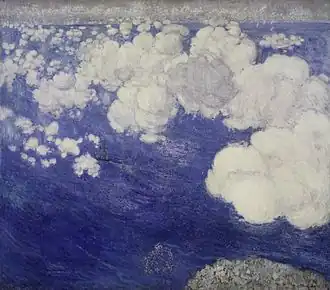Clouds over the Black Sea - Crimea
| Clouds over the Black Sea - Crimea | |
|---|---|
 | |
| Artist | Boris Izrailevich Anisfeld |
| Year | 1906 |
| Catalogue | P 150 |
| Medium | Oil on canvas |
| Movement | Russian symbolism |
| Subject | View of the Black Sea from Ayu-Dag, Crimea, Ukraine |
| Dimensions | 125.7 cm × 142.2 cm (49.5 in × 56 in) |
| Location | Brooklyn Museum, Brooklyn |
| Accession | 33.416 |
| Website | https://www.brooklynmuseum.org/objects/4705 |
Clouds over the Black Sea - Crimea is a 1906 painting by Moldovan-American artist Boris Anisfeld. The painting depicts a
cloudscape view of the Black Sea, over in Crimea. Anisfeld placed himself at the summit Ayu-Dag mountains to get a bird's eye view of the expanse.[1]
Considered a prominent piece of pre-October Revolution Russian symbolist art, it is currently on display at the Brooklyn Museum.[1]
Description
In 1895, at the age 17, Anisfeld spent his education in Southern Ukraine in the Grekov Odesa Art School, a prominent entry point for Ukrainian Jewish community to enter into Russian art institutions. Such flexibility and freedom was pronounced in Odesa, according to Marc Chagall's autobiography (at the time Odesa reached a peak of 40% Jewish in 1897).[2]
Following additional education at the Imperial Academy of Arts in Saint Petersburg, Anisfeld spent his leave of absence in Odesa in 1901. And in during the late 1900s, after settling in Paris, in 1906 made multiple trips to the Neva, Western Dvina, and the Dnieper, painting landscapes, taking his basis in the Blue Rose style of Symbolism.[3][4]
Anisfeld took his cues from nature:
In painting I think in colour first. I paint what I think, not always what I see. In summer I paint only from nature and try to express my impressions of nature in all her phases. I do not always paint the colour another might see, but only what my impression of the scene is at the time. My moods vary, and I paint the scene before me to correspond with my mood of the moment.[3]
With Clouds over the Black Sea - Crimea, Anisfeld scoped the Black Sea on the summit of the Ayu-Dag yet the painting is placed as if on midair, imagining a height above the clouds from where he stood, without the use of hot air balloon or plane. The site at the time was considered a popular destination for outdoor painting at the time.[1]
The clouds, extends distant to the horizon gives depth and dimension, yet Anisfeld, with Symbolist style instead merges the sky and sea onto a flat, single plane, a divergence from more realist style. A bit of the Ayu-Dag peak is shown on the lower right, while a warship and sailboats pepper the sea.[1]
The painting debuted at the 1906 Salon d'Automne in Paris, in an exhibition organized by Sergei Diaghilev, who Anisfeld collaborated with for stage sets and costumes.[1] The painting saw additional exhibition in Berlin in 1906, Moscow in 1907-8, St. Petersberg in 1908, and Vienna in 1908.[5]
After the Russian Revolution, Anisfeld fled to the United States, and within a year had his American debut at the Brooklyn Museum in 1918, who helped with his emigration via export permit for his works.[1][4] The painting as additional exhibition in Worcester, Massachusetts in 1924, followed by Boston from 1924-5.[5]
Following the suicide of his wife Frieda Glaeserman in 1933, he donated the work in memory of her at the Brooklyn Museum, where it has been in the permanent collection since under Accession Number 33.416.[1][5]
References
- ^ a b c d e f g "Clouds over the Black Sea--Crimea". Brooklyn Museum. Retrieved 2025-07-14.
- ^ "Boris Anisfeld / catalogue raisonné". anisfeld.org. Retrieved 2025-07-14.
- ^ a b "The Intellectual–Historical Context after 1900 – Russian Symbolism". anisfeld.org. Retrieved 2025-07-14.
- ^ a b "Boris Anisfeld / Biography". anisfeld.org. Retrieved 2025-07-14.
- ^ a b c "Boris Anisfeld / paintings". anisfeld.org. Retrieved 2025-07-14.